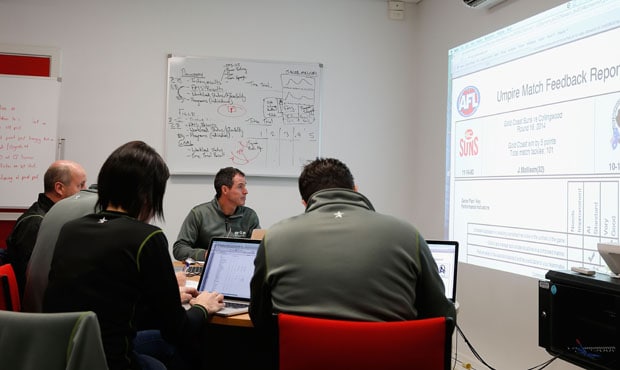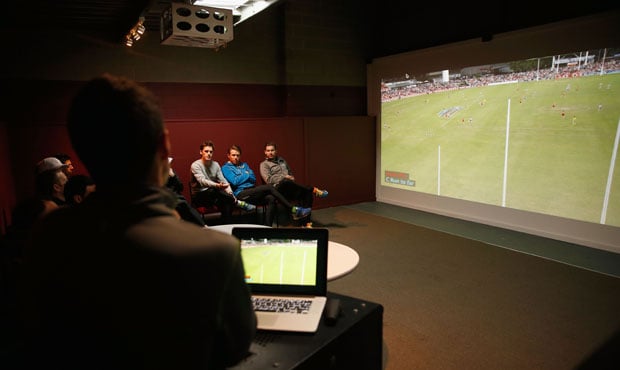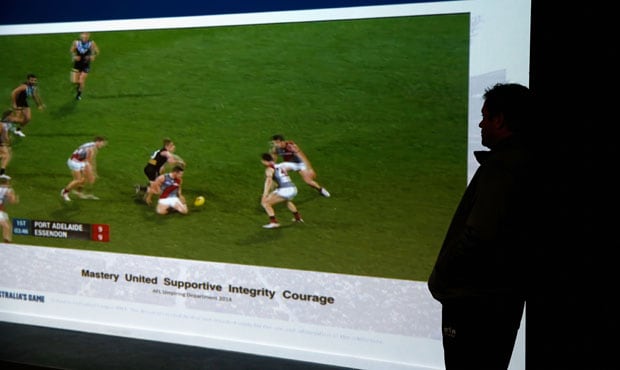IT IS bitterly cold and eerily quiet at Visy Park on Wednesday morning leading up to round 17. There’s a biting wind and rain is blowing sideways. The main training session for the umpires that afternoon promises to be an ordeal.
Carlton's players and coaches have the day off, while the Melbourne Rebels, the other major tenant at Visy Park, are winding up the season in South Africa, meaning the AFL umpiring department has the run of the joint.
Shortly after 11am, in a meeting room beneath the Pratt Stand, the umpiring coaches sit facing a blank wall, upon which the weekly assessments for the 27 field umpires from last week are projected.
AFL umpires’ coach Hayden Kennedy runs the meeting, with input from assistants Michael Vozzo, Bryan Sheehan and Michael Jennings, who have graded each game and will meet individually over the first part of the week with every umpire. Analyst Briana Harvey and AFL national umpiring director Wayne Campbell also sit in.
Using software from Champion Data, every on-field decision for each umpire is charted by time, zone, the players involved, whether it was correct, missed or unwarranted, what sort of contest it was, the reason for the decision (or non-decision) and with a comment from the coach.
Each centre bounce is also graded as follows: straight, offline, badly offline, recalled.
It is a painstaking but necessary process, with every umpire assessed for about three minutes each. Everything gets noticed – even the fact one umpire went an entire match without taking a bounce.
The feedback is eye-opening for anyone whose view of football is usually confined to the prism of the two competing teams.
Each umpire is taken through a detailed video review of their performance each week. Picture: AFL Media.
The coaches look for strong communication, work-rate, decision-making and leadership. One umpire is being coached not to get sucked too far into packs, his progress factored into his assessment. Another earns strong marks because he protected the ball carrier.
With just a couple of mouse clicks, the coaches can look at any decision from the weekend, using either the match broadcast pictures or behind-the-goal vision.
The reviews continue. Sheehan lauds one umpire for his leadership. Campbell asks why and is told the umpire in question gestured strongly to his fellow umpires because they were standing too deep in their end zones.
Sheehan also reveals he made contact with an umpire through the on-field communication device during a match on the weekend to praise him for two decisions he had made.
This sparks a lively debate between all those in the room about the merits of doing this. The argument in favour is that it helps the confidence of the umpires if they receive regular positive reinforcement, even in games.
"If you've got something to say to add to the performance, then say it," says Kennedy.
However the worry is the precedent it creates; if the umpires aren't hearing such praise during games, will it plant seeds of doubts in their minds? Finally, Campbell declares he loves the idea, as long as it is used sparingly.
The meeting wraps up in just over an hour. Afterwards, the coaches reflect on comments from Sydney Swans coach John Longmire the day before about the lack of resources in the AFL umpiring department. Longmire’s main argument was that the umpires from the previous weekend's game against West Coast had yet to be fully graded, nearly 48 hours after it was completed.
Campbell is still getting used to wearing his new hat as head of the umpiring department and can understand Longmire's frustrations. "He made some valid points, but his starting point was invalid."
Campbell expands later: "There are more resources now than in the past and it must be remembered that five of the six of us involved in umpire coaching are in their first six months on the job. With that will come some mistakes, but we will learn from them and get better."
Over lunch and as they wait for the first group of umpires to arrive for training, the coaches also discuss what happens when a coach publicly discusses the treatment his player receives from an umpire. Again it stems from remarks by Longmire, this time about Lance Franklin, who came in for some heavy treatment from West Coast's Eric Mackenzie the previous weekend.
Will the umpires be whistle-happy when it comes to Franklin? Or will they become even more defensive, waiting until they are, as one of their coaches suggested, "110 per cent sure" he has been infringed against before blowing their whistle? Again, the opinions around the room are divided. But with a journalist in the room, they are not about to express a view even remotely controversial.
At 1pm, 11 field umpires take their seats in the Rowan Sawers Room, a newly built meeting room that adjoins the umpiring headquarters beneath the Richard Pratt Stand.
One of the first changes under the new Campbell-Kennedy management of the umpiring department was to give umpires whose circumstances allow the option of completing their main coaching and training session on a Wednesday afternoon, rather than in the evening.
Among those who have taken up the option are Ray Chamberlain, Matt Stevic, Leigh Fisher, Brett Rosebury and Troy Pannell, Sam Hay and Ben Ryan.
By this time, most of the umpires have had their 15-minute debrief with one of the observers from the weekend and some are charged with taking their colleagues through sections of their own review, as part of the coaching for the week.
Ryan, who graduated to the AFL senior list from Queensland, returned to his home state for the Gold Coast-Collingwood match and talks confidently through his match vision. The key talking point for just about everyone out of that match was the season-ending elbow injury to Suns superstar Gary Ablett and the incident is replayed at length during Ryan's presentation.
Yet for the umpires, the injury and its ramifications for Ablett's Brownlow Medal hopes and Gold Coast's finals aspirations are of no concern whatsoever and are not even discussed. What interests them is that the decision to penalise Ablett for incorrect disposal was the correct one.
If there was one theme to emerge from the meeting it is positioning. Where the umpires are located during stoppages is regarded as critically important, particularly now that they are encouraged to pay free kicks whenever and wherever they see them, even if they are not in control at that moment.
But it is very much a two-way meeting and Kennedy, who just three years ago was one of the boys, is happy for some of the senior umpires, particularly Stevic and Chamberlain, to lead the discussion. And over the course of the meeting, every umpire in the room is challenged.
AFL umpires’ coach Hayden Kennedy runs the feedback meeting. Picture: AFL Media.
They are in and out of the room in 30 minutes and shortly afterwards are out on the middle of Visy Park. With the temperature barely nudging double figures and rain steadily pelting down, the umpires train for the second time that week.
The session starts with a series of strides, sprints and an 800m dash, before a series of specific umpire-related training drills.
They practice their bouncing and then running backwards between a series of cones. In one full-ground drill, they run 40m at pace to one cone, blow their whistle, signal a decision and then run to another cone. From there they run backwards for a bit, then turn and run further up the ground.
They also practise running to the mark, signalling a free kick and lining up an angle; footballs are rolled quickly towards their feet and they have to run backwards to avoid touching them.
It's a 45-minute slog, cut short because of the weather and geared towards the fundamentals. But what is also apparent from watching the umpires at training is what they do with a ball in their hand. While the inclination for most of us when a footy lobs in our hands is to kick or handball it, the umpires simply caress it or practise taking a bounce, which after all, is their craft. Only Fisher, a former St Kilda player, picks up a footy and gives it a roost.
Once inside, the umpires retreat to the warmth of the gym for some stretches and weights, while the coaches return upstairs, where the first of the remaining umpires have started to drift in from work. It is time for the second shift.
Photography and video by Lachlan Cunningham; video editing by Eddie Paynter.






